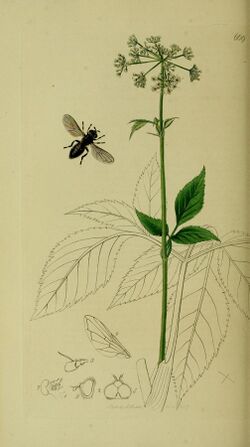Biology:Trichopsomyia
| Trichopsomyia | |
|---|---|

| |
| Trichopsomyia flavitarsisIllustration in British Entomology | |
| Scientific classification | |
| Domain: | Eukaryota |
| Kingdom: | Animalia |
| Phylum: | Arthropoda |
| Class: | Insecta |
| Order: | Diptera |
| Superfamily: | Syrphoidea |
| Family: | Syrphidae |
| Subfamily: | Pipizinae |
| Tribe: | Pipizini |
| Genus: | Trichopsomyia Williston, 1888[1] |
| Type species | |
| Trichopsomyia polita Williston, 1888[1]
| |
Trichopsomyia is a genus of Hoverflies, from the family Syrphidae (flower flies), in the order Diptera.[2][3]
Biology
Hover flies like the Trichopsomyia are small flies with large heads and eyes, and small antennae. Their bodies are medium to slender, with a waist that is not significantly narrow, unless it is a wasp mimicking species. They have one pair of clear wings, and the banded forms have yellow and black bands. Hoverflies resemble wasps or bees because of their black and yellow-striped abdomens. However, they are actually members of a fly family that have evolved to mimic wasps and bees for protection.[4]
Hoverfly larvae are flattened, legless and maggot-like. Most are green or brown in colour. They are carnivorous and eat aphids.
Species
- Trichopsomyia antillensis(Thompson, 1981)
- Trichopsomyia apisaon Walker, 1849
- Trichopsomyia australis (Johnson, 1907)
- Trichopsomyia currani (Fluke, 1937)[5]
- Trichopsomyia banksiCurran, 1921)
- Trichopsomyia biglumis(Matsumura, 1916)
- Trichopsomyia boliviensis (Shannon, 1927)
- Trichopsomyia flavitarsis (Meigen, 1822)[6]
- Trichopsomyia granditibialis (Fluke, 1937)[5]
- Trichopsomyia lasiotibialis (Fluke, 1937)[5]
- Trichopsomyia joratensis Goeldlin, 1997
- Trichopsomyia litoralis Vockeroth, 1988
- Trichopsomyia longicornis (Williston, 1888)[1]
- Trichopsomyia lucida (Meigen, 1822)[6]
- Trichopsomyia nigritarsis (Curran, 1924)
- Trichopsomyia occidentalis (Townsend, 1897)
- Trichopsomyia ochrozona (Stackelberg, 1952)
- Trichopsomyia pilosa (van Steenis & Wyatt, 2020)
- Trichopsomyia polita Williston, 1888[1]
- Trichopsomyia pubescens (Loew, 1863)
- Trichopsomyia puella (Williston, 1888)[1]
- Trichopsomyia recedens (Walker, 1852)
- Trichopsomyia rufithoracica (Curran, 1921)
- Trichopsomyia similis (Curran, 1924)
- Trichopsomyia tuberculata (Williston, 1888)
- Trichopsomyia tshapigou (Kuznetzov, 1990)
- Trichopsomyia urania (Hull, 1949)
References
- ↑ 1.0 1.1 1.2 1.3 1.4 Williston, Samuel Wendell (1888). "Diptera Brasiliana, ab H. H. Smith collecta. Part I, Stratiomyidae, Syrphidae". Transactions of the American Entomological Society 15: 243–292. https://www.biodiversitylibrary.org/page/7522969#page/253/mode/1up. Retrieved 5 July 2021.
- ↑ Van Veen, M.P. (2004). Hoverflies of Northwest Europe, Identification Keys to the Syrphidae (Hardback). Utrecht: KNNV Publishing. p. 254. ISBN 90-5011-199-8.
- ↑ Stubbs, Alan E.; Falk, Steven J. (1983). British Hoverflies: An Illustrated Identification Guide. British Entomological & Natural History Society. p. 253, xvpp.
- ↑ "Hover flies". http://australianmuseum.net.au/Hover-flies#sthash.NmPLiPFl.dpuf.
- ↑ 5.0 5.1 5.2 Fluke, C.L. Jr (1937). "New South American Syrphidae". Am. Mus. Novit. 941: 1–14. https://digitallibrary.amnh.org/bitstream/handle/2246/2182//v2/dspace/ingest/pdfSource/nov/N0941.pdf?sequence=1&isAllowed=y.
- ↑ 6.0 6.1 Meigen, Johann Wilhelm (1822). Systematische Beschreibung der bekannten europäische n zweiflugeligen Insekten. Hamm: Dritter Theil. Schulz-Wundermann. pp. x, 416, pls. 22–32. https://www.biodiversitylibrary.org/item/49298#page/7/mode/1up. Retrieved 14 April 2019.
Wikidata ☰ Q2745424 entry
 |
